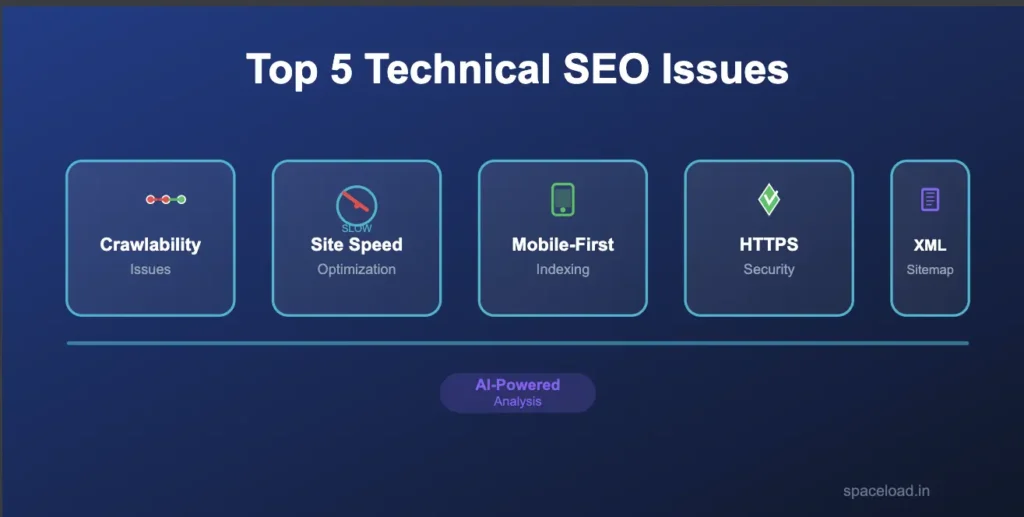Running a website without proper technical SEO is like opening a restaurant with a broken front door – you might have the best content in the world, but if search engines can’t properly access and understand your site, your potential customers will never find you. Whether you’re a business owner in Dallas, a startup in New York, or an entrepreneur anywhere across Texas and Ohio, this comprehensive technical SEO audit checklist will help ensure your website is primed for success in 2025.
After working with hundreds of websites across various industries, we’ve seen firsthand how technical issues can silently sabotage even the most promising online ventures. The good news? Most technical SEO problems are fixable once you know what to look for.
Why Technical SEO Matters More Than Ever in 2025
Search engines have become incredibly sophisticated, but they still need clear signals to understand and rank your website effectively. Google processes over 8.5 billion searches daily, and websites with solid technical foundations consistently outperform those with overlooked technical issues. A proper technical SEO audit checklist serves as your roadmap to identifying and fixing these invisible barriers to success.
The Complete Technical SEO Checklist for 2025

1. Website Crawlability Assessment
Before search engines can rank your pages, they need to crawl them. Website crawlability issues are among the most common yet overlooked problems we encounter during SEO site audits.
Action items:
- Check your robots.txt file (/robots.txt) to ensure it’s not blocking important pages
- Verify that your XML sitemap is properly submitted to Google Search Console
- Review internal linking structure to ensure all important pages are discoverable
- Identify and fix orphaned pages that lack internal links
2. Site Speed Optimization
Page speed directly impacts both user experience and search rankings. With Core Web Vitals now a confirmed ranking factor, this element of your technical SEO audit checklist demands immediate attention.
Key metrics to monitor:
- Largest Contentful Paint (LCP): Should occur within 2.5 seconds
- First Input Delay (FID): Should be less than 100 milliseconds
- Cumulative Layout Shift (CLS): Should be less than 0.1
Quick fixes:
- Compress images using modern formats like WebP
- Minimize CSS, JavaScript, and HTML files
- Enable browser caching
- Consider a Content Delivery Network (CDN) for faster global loading
3. Mobile-First Indexing Compliance
With mobile-first indexing fully rolled out, your mobile version is what Google primarily uses for ranking and indexing your content.
Verification steps:
- Ensure mobile version contains all content from desktop
- Check that mobile site loads quickly
- Verify structured data is present on mobile pages
- Test mobile usability in Google Search Console
4. HTTPS Security Implementation
Security isn’t just about protecting user data – it’s a ranking factor. Every page on your website should be accessible via HTTPS.
Security checklist:
- Install valid SSL certificate
- Redirect all HTTP URLs to HTTPS versions
- Update internal links to use HTTPS
- Check for mixed content warnings
5. URL Structure Optimization
Clean, descriptive URLs help both users and search engines understand your content hierarchy.
Best practices:
- Use hyphens to separate words
- Keep URLs under 60 characters when possible
- Include target keywords naturally
- Implement consistent URL structure across your site
6. XML Sitemap Maintenance
Your XML sitemap serves as a roadmap for search engines, guiding them to your most important content.
Sitemap essentials:
- Include only canonical URLs
- Keep sitemaps under 50,000 URLs
- Update last modified dates accurately
- Submit sitemaps to Google Search Console and Bing Webmaster Tools
7. Duplicate Content Resolution
Duplicate content can dilute your SEO efforts and confuse search engines about which version to rank.
Common sources to check:
- WWW vs non-WWW versions
- HTTP vs HTTPS versions
- Trailing slash variations
- Parameter-based duplicates
- Product variations with similar content
8. Structured Data Implementation
Structured data helps search engines understand your content context, potentially earning you rich snippets in search results.
Priority schema types:
- Organization markup for business information
- Article markup for blog posts
- Product markup for e-commerce sites
- Local Business markup for location-based businesses
- FAQ markup for frequently asked questions
9. Internal Linking Strategy
Strategic internal linking distributes page authority throughout your site and helps search engines discover content.
Internal linking best practices:
- Use descriptive anchor text
- Link to relevant, related content
- Create topic clusters around main subjects
- Ensure important pages receive adequate internal links
10. Image Optimization Protocol
Optimized images improve page speed while providing additional ranking opportunities through image search.
Image optimization steps:
- Add descriptive alt text to all images
- Use appropriate file formats (JPEG for photos, PNG for graphics)
- Compress images without sacrificing quality
- Implement lazy loading for images below the fold
- Include descriptive file names
11. 404 Error Management
Broken links create poor user experiences and can waste crawl budget on larger sites.
Error monitoring approach:
- Regularly audit for 404 errors using Google Search Console
- Set up 301 redirects for permanently moved content
- Create a helpful custom 404 page
- Monitor external links pointing to your site
12. Core Web Vitals Optimization
These user experience metrics directly impact search rankings and visitor satisfaction.
Optimization strategies:
- Minimize server response times
- Optimize resource loading order
- Eliminate render-blocking resources
- Reduce layout shifts from dynamic content
13. JavaScript SEO Considerations
Modern websites often rely heavily on JavaScript, but search engines can struggle with certain implementations.
JavaScript SEO checklist:
- Ensure critical content renders without JavaScript
- Use server-side rendering when appropriate
- Implement proper URL management for single-page applications
- Monitor JavaScript errors that might impact crawling
14. Log File Analysis
Server logs provide insights into how search engines actually crawl your website, revealing patterns invisible through other tools.
Key insights from log analysis:
- Crawl frequency patterns
- Pages search engines prioritize
- Crawl budget utilization
- Server errors affecting crawlers
15. International SEO Setup
If your business serves multiple geographic markets, proper international SEO implementation is crucial.
International considerations:
- Implement hreflang tags for multi-language content
- Choose appropriate URL structure (subdirectories vs subdomains)
- Target location-specific keywords naturally
- Consider local hosting for improved regional performance
Tools for Your Technical SEO Audit Checklist
Successful technical SEO requires the right tools. Here are essential options for different budget levels:
Free tools:
- Google Search Console (essential for all websites)
- Google PageSpeed Insights
- Mobile-Friendly Test Tool
- Screaming Frog (free version)
Premium options:
- SEMrush Site Audit
- Ahrefs Site Audit
- Screaming Frog (paid version)
- DeepCrawl
Common Technical SEO Mistakes to Avoid
Through our experience auditing websites across Ohio, Texas, New York, and beyond, we’ve identified recurring issues that can severely impact search performance:
- Ignoring website crawlability issues until they compound into major problems
- Forgetting to update sitemaps after significant site changes
- Overlooking mobile optimization despite mobile-first indexing
- Neglecting page speed on content-heavy pages
- Implementing redirects incorrectly, creating redirect chains
Measuring Your Technical SEO Success
Track these key performance indicators to measure the impact of your technical SEO improvements:
- Organic search traffic growth
- Search Console crawl stats improvement
- Core Web Vitals scores
- Mobile usability error reduction
- Structured data implementation success rates
Moving Forward with Your Technical SEO Strategy
Technical SEO isn’t a one-time task – it requires ongoing attention and maintenance. Search engines constantly evolve their algorithms, and your website changes over time through content updates, new features, and structural modifications.
Schedule quarterly technical SEO audits using this checklist to catch issues early. Remember, small technical problems can snowball into significant ranking obstacles if left unaddressed.
Whether you’re managing a local business website in Dallas, running an e-commerce store serving customers across Texas and Ohio, or operating a national service business, this technical SEO audit checklist provides the foundation for sustainable search engine success.
The investment in proper technical SEO pays dividends through improved search visibility, better user experience, and ultimately, increased business growth. Start with the most critical issues – website crawlability, site speed, and mobile optimization – then systematically work through the remaining checklist items.
Your website’s technical health directly impacts your business’s online success. By following this comprehensive technical SEO checklist, you’re building the solid foundation necessary for long-term search engine visibility and user satisfaction.



